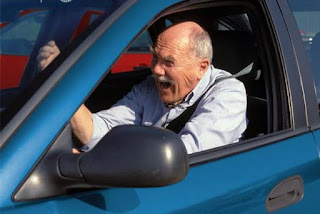Why is Road Rage Suddenly All the Rage?
By Diane Tait
 |
| Image courtesy flickr |
Why do drivers sometimes turn into thugs
behind the wheel? – Road rage isn’t something new. It started more than one hundred years
ago. In 1908, Detroit saw no fewer than
31 people killed in car crashes. Early
automobiles were noisy, which disturbed pedestrians and the horses that were
the dominant form of transportation at the time. Not only did horseless carriages disturb the
peace, but serious debate and a number of court cases were brought to determine
if the automobile was inherently evil.
According to the DetroitNews, The state of Georgia's Court of Appeals wrote: "Automobiles
are to be classed with ferocious animals and … the law relating to the duty of
owners of such animals is to be applied ... . However, they are not to be
classed with bad dogs, vicious bulls, evil disposed mules, and the like."
 |
| Image courtesy pxhere |
But even with speeding being rampant and driver training practically
nonexistent in the early 1900’s, many traffic incidents devolved into arguments
and fistfights. It wasn’t until the 1980’s that gunplay began to occur on the
streets following a traffic incident. The
first reported fatality occurred in the summer of 1987 when a 24-year-old
father was shot for going too slow in the passing lane on the LA Freeway. That touched off a series of road rage
incidents that left five dead and eleven wounded before the summer was
over. The LA Times labelled the
incidents as “Highway Hostility”. For a
time after that fateful summer, drivers in Los Angeles began to be more
courteous to other drivers for fear that they too would get shot. Traffic actually improved briefly on the LA
Freeway as skittish drivers opted to take surface streets to reach their
destination rather than tempt fate.
However, some drivers took to arming themselves in the event that things
got ugly. The California Highway Patrol
responded by putting an additional 150 uniformed officers om the street and the
courts went to the extreme of making the carrying of a weapon in a glove-box a
felony with an automatic 3-year sentence.
While cooler heads inevitably prevailed as time moved on, it wasn’t long
before road rage migrated to other major metropolitan areas across the US.
 |
| Image courtesy pixabay |
From a psychological standpoint, road rage stems from one of three
factors. Many mild-mannered people
immediately become more aggressive behind the wheel simply because they feel
less likely to be held accountable for their actions. The technical term for this phenomenon is
deindividuation. I myself have seen this
phenomenon in action recently in a supermarket parking lot when a mother with three
young children in her minivan loudly harangued me for pulling into what she
said was her parking spot even though there was no clear indication that she
was even trying to park. Psychologists have
conducted numerous studies that showed that societal norms are easily discarded
when individuals feel anonymous.
Optimism bias is another factor that leads to everything from road rage
to social shunning by people who feel that they are superior to others. This isn’t a rarity but rather the norm,
since 88% of people polled in the US believed they were safer drivers than the
average motorist. These are also the
people who typically get mad when others don’t live up to their expectations on
the road.
Personal stress can also be a deciding factor when it comes to expressing
anger on the road. Stresses from work
and home are easily transferred to those around us, especially those we don’t
know.
How should you deal with road rage?
The best way to avoid being involved in a road rage incident is to keep
your cool when behind the wheel. Just as
it takes two to tango, it also takes two drivers to have a road rage
incident. That means you should use lane
discipline instead of road hogging, give drivers entering the highway the
opportunity to merge with traffic by slowing down, never escalate a bad
situation into a worse one if a driver suddenly zooms up behind you and honks
or flashes their high beams and never pull over if a driver near you reacts
angrily. Better to call 911 to report a road
rage incident than to wind up being accosted or assaulted by an irate driver. Last but not least, don’t overreact if a
driver ahead of you cuts you off or slows to a crawl. Florida isn’t only one of the most visited
states in the Union, it’s also the number one state for road rage incidents
that have resulted in gunfire.
Diane Tait
owns and operates A&B Insurance. To find out more about how you can save
money on insurance, go to her site or fill out the form at right.


Especially with the current crisis, you need to be twice as nice on the road.
ReplyDeleteI know road rage is not new but when, but when people are under a lot of stress it's easier for people to blow up than stay clam.
ReplyDelete